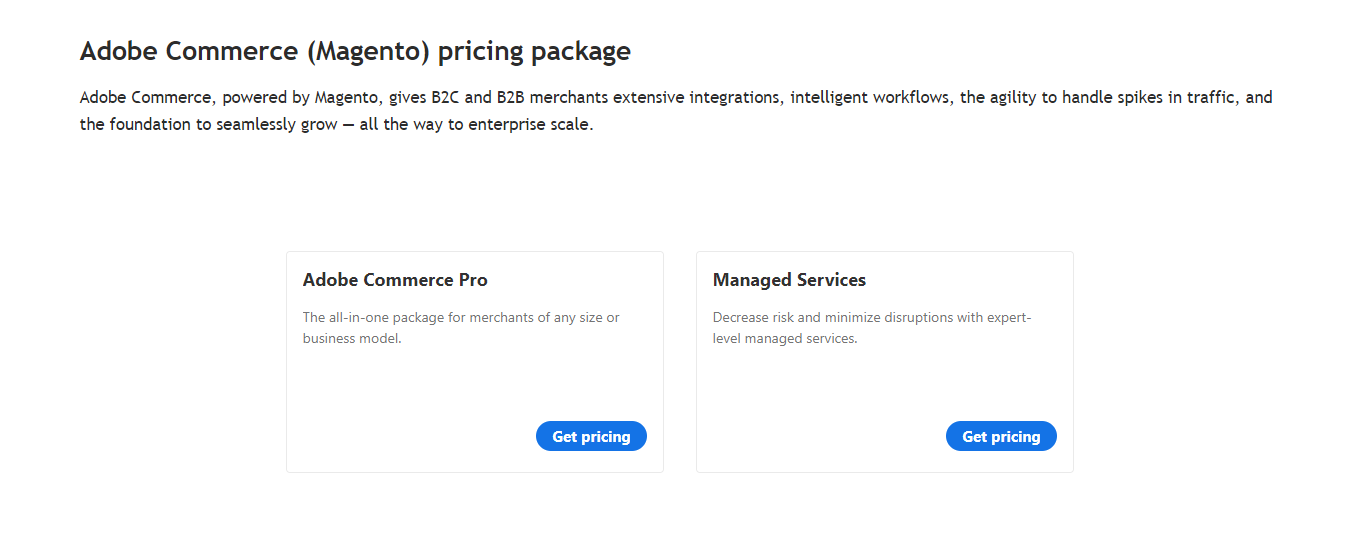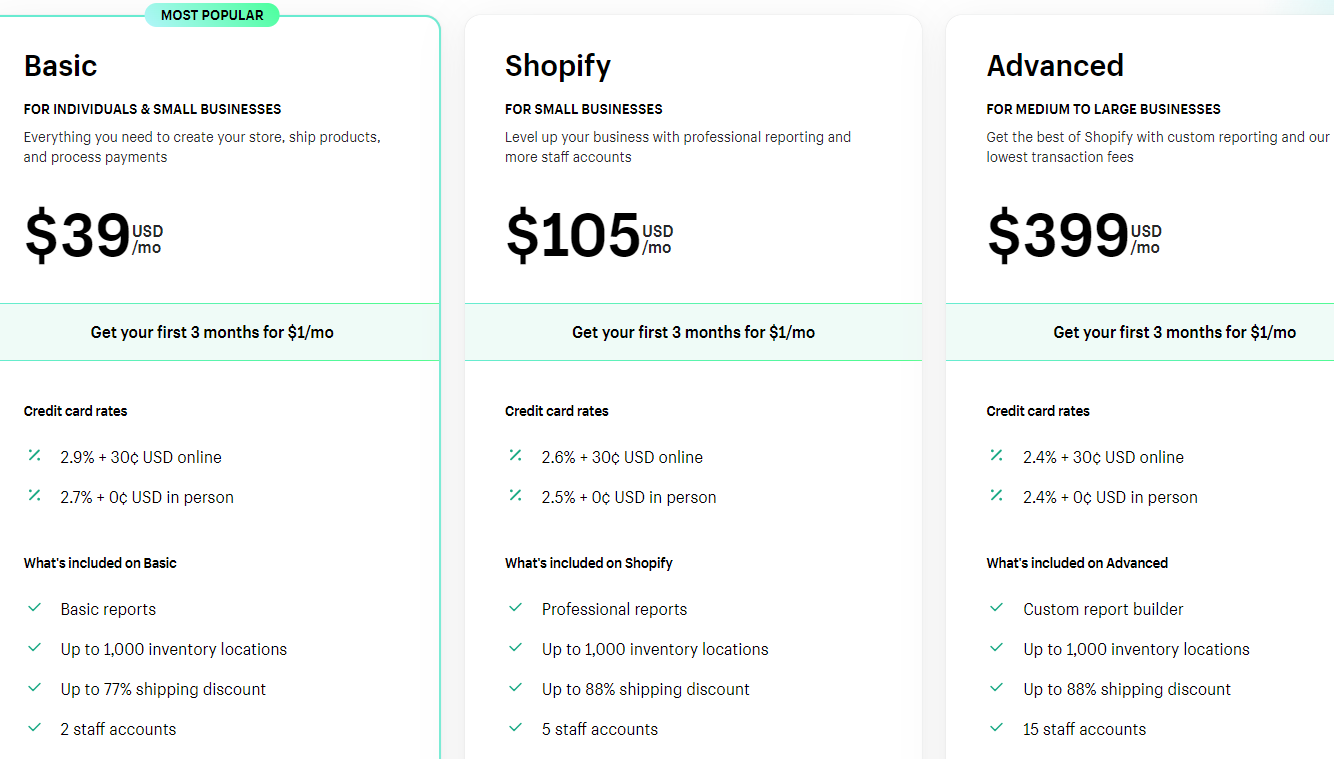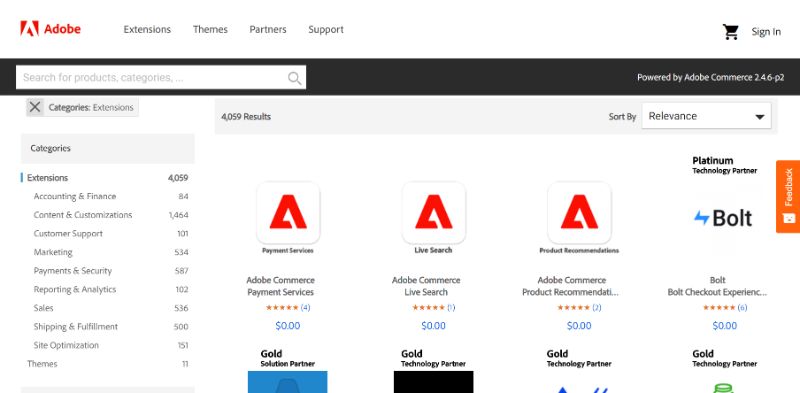Magento vs Shopify Comparison: Which One is Better?
In today’s digital era, selecting the right e-commerce platform for your business is crucial. Two of the giants in this field are Magento and Shopify. But which is right for you?

Quick Verdict
Navigating the world of e-commerce platforms can seem overwhelming. With industry leaders like Shopify and Magento providing comprehensive solutions, it’s essential to understand what each platform offers. Let’s delve into why one might prefer Shopify over Magento and vice versa.
Key reasons to use Shopify instead of Magento
- Ease of use: Setting up an online store shouldn’t require technical expertise. Shopify provides an intuitive interface along with a user-friendly store builder. This means you can design and launch a professional online storefront without delving into technical complexities.
- Quick Setup: Time is valuable, and with Shopify, you can save a significant amount of it. You can have your store up and running in just a few hours, which is a compelling advantage for businesses eager to launch without delays.
- App Marketplace: Adaptability is crucial in today’s fast-paced e-commerce environment. Shopify’s impressive app marketplace allows you to enhance your store with a wide range of features, from customer reviews to comprehensive analytics.
Key reasons for using Magento instead of Shopify
- Advanced Customization: Magento is the choice for those who value flexibility. Its open-source framework allows you to customize nearly every online store aspect. If Shopify feels somewhat limiting and you have specific, unique requirements, Magento might be the better solution.
- Scalability: Size is significant, particularly in e-commerce. If you anticipate an extensive product catalog or expect surges in traffic, Magento is designed to handle such demands, making it a suitable choice for more extensive enterprises.
- Broad range of Features: Features can significantly impact the e-commerce experience. Magento excels in this area, providing users with many built-in tools. These include advanced SEO utilities, detailed customer segmentation, efficient product bundling, and more. While Shopify can potentially offer some of these features through its apps, Magento’s inherent capabilities provide a seamless, integrated experience.
Pros and Cons
Two prominent players in this field, Magento and Shopify, are often evaluated because of their robust capabilities and unique offerings. However, like everything else, each has its strengths and weaknesses. Let’s evaluate the main benefits and limitations of both platforms.
Magento
Pros:
- Highly Customizable: Magento’s open-source nature is a significant advantage for those eyeing a distinct online presence. With it, you can mold your online store to reflect your brand’s essence, ensuring a unique customer experience.
- Scalable: Magento’s robust architecture promises scalability. If you’re a larger enterprise with an extensive product list or anticipating high web traffic, Magento caters to these demands effectively.
- Rich Feature Set: With Magento, feature richness is a given. The platform boasts advanced SEO tools, detailed customer segmentation, efficient product bundling, and more right out of the box.
Cons:
- Technical Expertise Needed: Magento’s extensive capabilities come with a catch. To fully utilize its potential, some level of technical skill is necessary. This can be intimidating for beginners or individuals without an IT support team.
- Elevated Operational Expenses: Although the platform itself may not incur charges, it’s important to note that the combined expenses of hosting, development, and continuous upkeep can increase, potentially making Magento more costly over time.
Shopify
Pros:
- Ease of Use: Shopify simplifies the e-commerce journey. With its intuitive interface and user-friendly drag-and-drop builder, anyone can craft a sleek online store without technical hitches.
- Quick Setup: Time-conscious businesses will appreciate Shopify’s efficient setup process. Your online storefront can be live and ready to attract customers in mere hours.
- App Marketplace: Flexibility is crucial, and Shopify’s vast app marketplace ensures that. Whether you need analytics, reviews, or any other functionality, there’s likely an app for that.
Cons:
- Limited Customization Options: Every platform has its constraints. While Shopify provides customization, it doesn’t quite match Magento’s breadth. Businesses with particular design needs might find this limiting.
- Transaction Fees: Costs always matter. If you opt for third-party payment gateways over Shopify Payments, be prepared for additional transaction fees, potentially increasing your overall expenses.
Overview
Magento vs Shopify: Our Expert Review
In the world of online shopping platforms, Magento and Shopify stand out as two leading choices. Both offer unique benefits, but they cater to different needs. In this comparison, we closely examine what each platform offers to help you decide.
Magento is a flexible platform that lets you customize a lot. With many add-ons available in its store, it’s great for big businesses or those with special needs. However, you might need technical know-how to get the most out of it.
On the other hand, Shopify is easy to use and set up. It has many built-in tools and a big app store, making it perfect for small to medium businesses. Its main advantage is its simplicity, even if you’re not tech-savvy.

We’ve looked at everything from how they handle search engine rankings, payment methods, blogging, and customer help. So, whether you’re experienced in online sales or just starting, this guide can help you pick the best platform for your needs.
Pricing
When deciding on an e-commerce platform, pricing plays a crucial role. Both Magento and Shopify offer a range of plans tailored to different business needs. Let’s break down”
Magento
In Magento’s pricing structure, there are two main versions of its platform that deserve attention:

- Adobe Commerce Pro: This edition is intended for businesses that require an advanced, scalable, and highly customizable e-commerce solution. It provides robust out-of-the-box capabilities, deeper integrations, higher performance optimization, and security features. So, the cost typically depends on the business size and specific needs, and it’s best to consult Adobe for a quote.
- Managed Services: This package deals with hosting and managing the technical aspects of your Magento store so businesses can focus on their core operations without worrying about technical issues. It might include server maintenance, regular backups, security monitoring, and other technical tasks to ensure the smooth running of the online store.
Adobe Commerce Pro offers a robust and scalable e-commerce solution tailored for larger businesses or those with intricate needs. While its advanced features are a boon for many, they might be excessive for smaller businesses.
Meanwhile, Managed Services handles the technicalities of the Magento platform, allowing businesses to focus on their core operations. Both services are comprehensive but require businesses to assess their specific needs against the potential costs, as pricing often demands a tailored approach.
Shopify

Shopify offers a range of pricing plans designed to cater to businesses of varying sizes and needs.
- Basic Plan ($39 USD/month): The Basic Plan is tailored for individuals and emerging businesses. It provides essential tools for setting up an online store, including store creation features, shipping functionalities, and payment processing capabilities. This plan is an excellent choice for those just starting in e-commerce and looking for a cost-effective solution to establish their online presence.
- Shopify Plan ($105 USD/month): The Shopify Plan is aimed at established businesses aiming for growth and expansion. In addition to the features offered in the Basic Plan, it includes professional reporting tools and provides more staff account access. This plan is well-suited for businesses that have already gained some traction and require more advanced tools to manage their operations efficiently.
- Advanced Plan ($399 USD/month): The Advanced Plan is designed for larger enterprises with substantial e-commerce needs. It offers custom reporting capabilities, allowing businesses to generate tailored insights and analytics. Moreover, this plan boasts the most competitive transaction fees, making it an attractive choice for businesses processing a high volume of transactions. It provides a comprehensive suite of tools to support the growth and success of larger online stores.
It’s important to note that Shopify does impose transaction fees ranging between 1% to 2% for payments processed via third-party gateways
The Verdict
Shopify wins in terms of pricing structures
For entrepreneurs in the nascent stages or small-scale businesses, Shopify offers an appealing blend of transparent pricing and features, potentially proving more cost-effective
Ease of Use
Both Magento and Shopify, despite their robust features, offer distinctive user experiences tailored to different user groups.
Magento
Magento is designed explicitly with intermediate to advanced web developers in mind. Its inherent strength lies in a complex framework that promises extensive flexibility and control.
However, this complexity can pose challenges for newcomers or those lacking technical expertise. Nevertheless, once you surmount the initial learning curve, Magento unveils many customization options to align with the unique requirements of your business precisely.
Shopify
In contrast, Shopify is renowned for its user-friendly approach. It seamlessly empowers both novices and experienced users to establish online stores without coding skills. Shopify employs a section-based editor to present your online store’s essential elements with the utmost clarity. While it may not offer the drag-and-drop flexibility found in some competitors, this approach ensures that the structure of your store remains coherent and well-organized.
The Verdict
For those who prioritize a smooth and uncomplicated setup process, Shopify emerges as the preferred choice. It simplifies the journey from the initial concept to a live store, ensuring that every step is intuitive and accessible to users of all technical backgrounds.
Storefront Design
The design of your storefront is pivotal, serving as the visual handshake between your brand and potential customers. Both Magento and Shopify recognize the importance of this first impression, yet they approach storefront design somewhat differently.
Themes & Templates
The visual aesthetics of your eCommerce platform are paramount to crafting the first impression and ensuring visitor engagement. Both Magento and Shopify come equipped with themes and templates to aid this endeavor. Here’s how they stack up against each other. .
Magento

When it comes to design choices, Magento offers a rich array of options. There are more than 300 themes available on ThemeForest alone, all crafted by talented developers from various parts of the world.
Whether you’re on a budget or just starting out, you can find free Magento themes like TigrenPWA and B.Geek that serve as excellent starting points. On the other hand, if you desire a truly unique design, creating a custom theme may be necessary, requiring the skills of a developer, which could potentially increase your costs.
Shopify

Shopify ensures that its users have a wide range of design options at their disposal. With over 1,800 themes available on ThemeForest and a collection of 12 free and 147 premium themes on their platform, Shopify caters to various design preferences.
A significant advantage is that all Shopify themes are designed to be mobile-responsive, ensuring an optimal browsing experience across different devices. Retailers can customize their designs quickly , ensuring that their online store truly reflects their brand identity, all without coding.
The Verdict
For those looking for a diverse selection of design options that can be personalized without delving into the intricacies of coding, Shopify stands out as the superior choice.
Store Customizations
A unique and engaging online store can significantly enhance user experience and amplify brand identity. Let’s dive into what each platform brings to the table regarding store customizations.
Magento
Magento, being open-source, offers a vast landscape for customization. Beyond the basics like updating store details, Magento enables in-depth modifications of product pages.
Retailers can integrate custom logos and static files like JavaScript, CSS, fonts, and more, allowing for a bespoke storefront. Furthermore, its many themes and templates offer added functionality and design choices, catering to diverse needs.
Shopify
Shopify, lauded for its user-centric approach, ensures store customization is a breeze, even for novices. Its intuitive platform allows changes in layout, palette choices, fonts, and more without the need for code.
Beyond the visual, Shopify provides customization options for store emails, domains, and more, creating a cohesive brand experience. Additionally, its wide range of themes ensures retailers can align their store’s look with their brand vision.
The Verdict
While both platforms are formidable in their customization offerings, Shopify takes the lead for those who prioritize ease and a beginner-friendly experience without the complexities of coding.
Sales Tools
Running a successful online store isn’t just about having a visually appealing site and a smooth user experience. It’s also about leveraging the right sales tools to engage customers and increase revenue.
Magento
Magento presents an array of tools that have the potential to amplify your store’s sales. Through extensions like Omnisend, retailers can harness the capabilities of omnichannel marketing, seamlessly integrating email, SMS, and push notifications to provide a comprehensive customer experience.
Additionally, MageDelight aids store owners in recapturing potential sales by targeting customers who abandon their shopping carts. What sets Magento apart is its robust inventory system, which offers features such as bulk product imports, support for multiple product variants, detailed revenue reports, and visitor statistics.
Furthermore, Magento development services allows for a fully customized checkout experience, assisting in recovering abandoned shopping carts, and enables merchants to set both percentage and fixed price discounts.
Shopify
Shopify, a prominent player in the eCommerce arena, brings forth various sales tools. From Shopify Email for streamlined email marketing campaigns to Shopify Forms for lead generation and Shopify Inbox for real-time chat interactions, it offers an integrated approach to sales.
Additionally, Shopify excels in providing tools suitable for businesses at various stages, providing various complementary resources to streamline operations. Notable features include its abandoned cart recovery system and ability to seamlessly sell digital and physical products.
The Verdict
Shopify’s all-encompassing toolkit gives it a competitive edge over Magento in sales.
Marketing Features
Which should be used to utilize robust marketing tools that can enhance your business’s outreach and positively impact your revenue?
SEO Search Engine Optimization (SEO) is undeniably the backbone of the digital visibility of an online store. It can drive increased traffic when effectively utilized, enhancing sales opportunities and potential revenue growth.
Magento
Magento has been recognized for its inherent SEO capabilities. The platform provides integral features beneficial for SEO, such as tools for editing the robots.txt file, creating sitemap.xml, and setting up efficient page redirects.
However, like any platform, it has its challenges, notably issues like duplicate content arising from faceted navigation and inappropriate canonical tags. Additionally, the platform lacks a built-in blogging feature.
To optimize Magento’s SEO capabilities, experts often recommend several practices: pruning duplicate URLs, managing paginated URLs, focusing on content creation, especially blogs for informational keywords, implementing structured data for products, articles, and breadcrumbs, deciding how product variant pages should be managed, compressing images, and periodically checking for redundant apps.
Shopify
Shopify, another powerhouse in the eCommerce arena, also brings its specific set of SEO tools to the table. Right off the bat, Shopify provides a blog and an efficient way to manage redirects, which are beneficial for SEO.
However, it’s not without its challenges, primarily the risk of generating duplicate content. To maximize Shopify’s SEO potential, it’s advisable to regularly optimize titles and meta descriptions, initiate weekly site health reports, monitor and rectify broken links, keep file sizes in check, effectively manage schema markups, and strategically incorporate target keywords in product titles and descriptions.
The Verdict
Regarding SEO, Magento seems to have a slight advantage.
Blogging
Blogging isn’t just a medium to share thoughts; in the eCommerce world, it’s instrumental in attracting potential customers, positioning your brand as an industry thought leader, and optimizing for search engines.
Magento
Inherently being an open-source solution, Magento doesn’t offer native blogging functionality. However, this isn’t a limitation, as it permits the addition of a blog via extensions.
For those who wish to intricately weave their blog’s look and feel with their store’s aesthetics, Magento facilitates this by allowing a custom etc/view.xml file, inclusion of a personalized logo, addition of static files like JavaScript, CSS, and images, and the option to choose a specific layout. Moreover, the expansive list of Magento themes and templates serves to embellish further and extend your store’s features.
Shopify
Contrastingly, Shopify simplifies the blogging journey by providing built-in blog software. It’s a ready-to-use platform where you can either craft a new blog from scratch or migrate your existing WordPress content. Shopify ensures that managing the blog is seamless, offering features to draft posts, categorize content, and handle SEO settings effortlessly.
The Verdict
For entrepreneurs who seek a straightforward, in-built blogging solution, Shopify stands out as the optimal choice.
Email marketing is a strategic approach for eCommerce businesses to nurture customer relationships, enhance brand visibility, and drive significant sales.
Magento
While Magento doesn’t have a built-in email marketing feature, it compensates by offering a wide range of email marketing extensions that seamlessly integrate with your Magento store. These include well-regarded email marketing platforms such as Moosend, HubSpot, Campaign Monitor, GetResponse, SendInBlue, Omnisend, and MailChimp. Using these platforms provides businesses with powerful tools like automation, data-driven customer insights, and customized email campaigns.
Shopify
Conversely, Shopify simplifies the email marketing process by integrating it as a native feature through Shopify Email. This built-in system allows businesses to create, send, and track email campaigns directly within the Shopify platform. To ensure user-friendliness, Shopify Email offers features like adaptable templates, automated email sequences, and optimized campaign delivery.
The Verdict
Shopify undoubtedly takes the lead in email marketing.
Payments options
Let’s explore the payment solutions offered by Shopify and Magento to determine which platform excels.
Magento
Not to be outdone, Magento supports an impressive array of over 150 payment gateways. However, some gateways primarily serve enterprise-level businesses, such as WorldPay. Users must obtain them from the marketplace to integrate popular payment processors like Stripe or Square.
Another notable feature of Magento is its ability to enable direct selling on Amazon while simultaneously managing inventory through Magento. This integration can expand your reach into Amazon’s extensive customer base.
Shopify
Shopify features its in-house payment processor, Shopify Payments, notable for its absence of transaction fees—only standard credit card processing fees apply. Utilizing Shopify Payments means you won’t incur any additional transaction fees from Shopify; you’ll only be responsible for the credit card processor’s charges. Additionally, Shopify integrates with more than 100 diverse payment gateways. However, it’s important to note that, except for Shopify Payments, all these gateways involve a transaction fee set by Shopify. This extensive list includes well-known gateways like PayPal, Stripe, Amazon Pay, and Apple Pay.
The Verdict
Magento offers a more diverse selection and unique features, making it the preferred choice for businesses seeking flexibility and variety.
Apps & Add-ons
Apps and add-ons can make an online store more powerful. They help businesses add new features to their websites.
Magento
Magento has an extensive collection with about 5,000 tools. Amazingly, a lot of these are free. Some tools have a small price tag, while others are expensive.

Different companies make these tools; the price often depends on who made it. Some tools might also need a specialist to set them up. Here are a few popular Magento tools:
- Amasty Multiple Coupons - allows users to use many discount codes on one order, making customers happy.
- Product Pre-Order - automatically emails customers when new products arrive, showing how many people are interested.
- Remarkety - links your email marketing and social media with your store.
- Banner Slider - lets you add advertisement banners to your site, which could help you earn more money.
Shopify
Shopify has over 1,200 tools. These tools help with things like email marketing, delivery, and promotion on social media.

Here are some good tools from Shopify:
- Trust Hero - shows security symbols to make customers feel safe when paying.
- MailChimp - combines email marketing with your Shopify store to increase sales.
- Trackr - tells your customers where their orders are.
- Analytics Buddy - shows your website’s performance data in your Shopify dashboard.
The Verdict
Shopify’s collection is easier to use and often cheaper.
Support
Support is crucial for any online store. The faster you can address and fix any issues, the quicker you can return to serving your customers.
Magento
Magento, being a community-driven platform, has detailed user guides. These guides cover every step of setting up and managing your online store. They are packed with tips and advice from experienced Magento users.
While Magento doesn’t offer direct help, you’re covered if you use SiteGround for hosting. SiteGround is known for its excellent customer service. Their team can help with a wide range of questions related to Magento.
In short, even if Magento doesn’t directly assist, the active user community and the support from hosts like SiteGround mean you’re well-supported.
Shopify
Shopify stands out with its 24/7 live chat support. This ensures you can contact Shopify’s team anytime you face a problem. Additionally, Shopify has an active user forum where people share their experiences and solutions. This community support can be very helpful for practical advice.
Shopify offers specialized support to help with more complex issues if you have specific needs.
The Verdict
Magento offers many helpful resources with insights from a large user community.
Magento vs Shopify: Which one is for you?
You should use Shopify If…
- Beginner-Friendly: You’re new to the world of e-commerce and need a platform that’s simple to set up and navigate without getting into technical complexities.
- Budget-conscious: You’re seeking an affordable solution with transparent pricing that includes hosting and essential features without any hidden expenses.
- Integrated Solutions: You want access to an extensive app store where you can discover tools and integrations to enhance your store’s capabilities without requiring custom coding.
- 24/7 Support: You value having around-the-clock support available to assist you whenever you have questions or have questions.
- Visual Customization: You prefer a platform that allows you to customize the appearance of your store using drag-and-drop features, all without having to deal with complicated code.
- Quick Set-Up: You’re eager to launch your online store promptly and want to minimize the time spent on the initial setup.
You should use Magento If…
- Deep Customization: Your store has specific requirements that demand a high level of customization beyond just the visual aspect.
- Technical Know-How: You possess some technical background or have the resources to hire a developer who can tailor your store precisely to your vision.
- Scalability: You’re either planning to run or already operating a large-scale business and require a robust platform capable of handling a substantial product catalog and high website traffic.
- Community Support: You appreciate being part of a community where developers and users collaborate, sharing knowledge, plugins, and solutions to address various challenges.
- Open-Source Freedom: You value the flexibility of open-source platforms, allowing you to modify every aspect of your store, even if it entails managing hosting and security on your own.
- Comprehensive Features: You’re searching for a platform that offers a wide range of features right out of the box, even if it means a bit of a learning curve is involved. In summary, both Shopify and Magento cater to different audiences and fulfill distinct needs. Your choice should align with your business size, objectives, technical expertise, and growth aspirations. Carefully considering these factors will lead you to the platform that best fits your unique requirements.
Magento vs Shopify: FAQs
Making an informed decision between Magento and Shopify will depend on individual needs, technical comfort, and business goals. Both platforms have their strengths, and the choice ultimately depends on what aligns best with your e-commerce vision.
Conclusion
Choosing between Magento and Shopify is a pivotal decision for any e-commerce entrepreneur. Both platforms offer robust features, with Magento leaning towards customization and scalability and Shopify excelling in user-friendliness and quick setup.
New Posts






